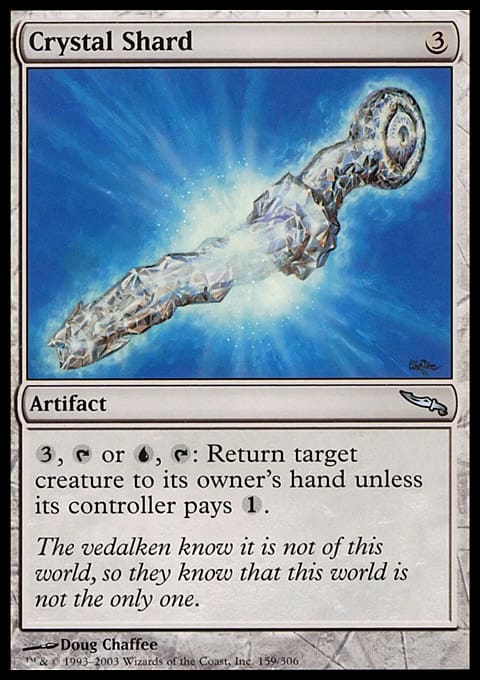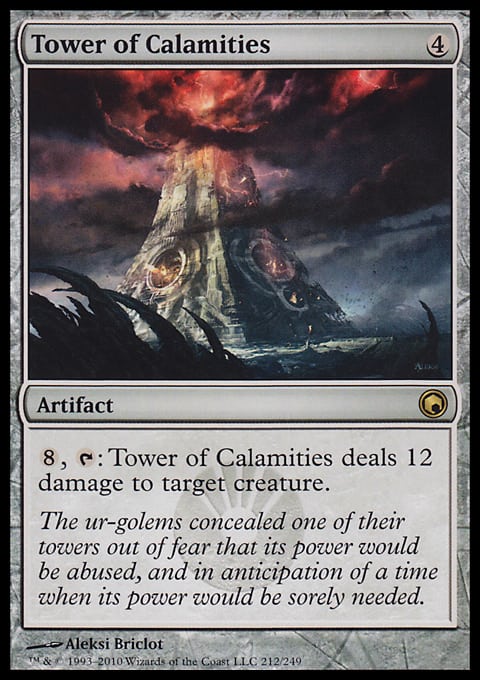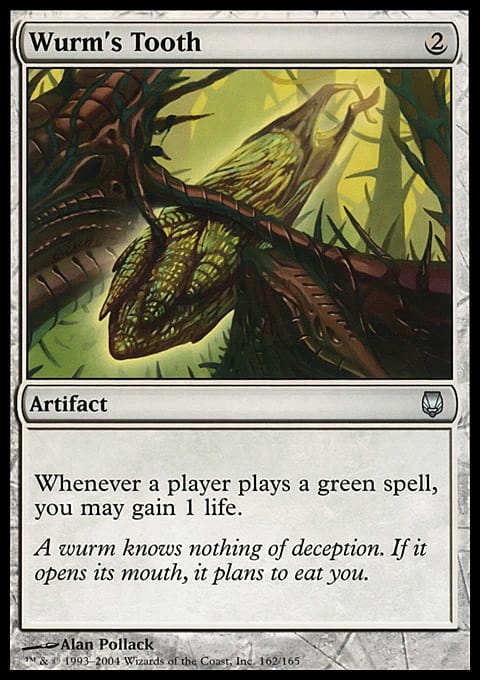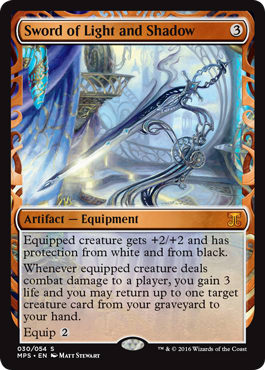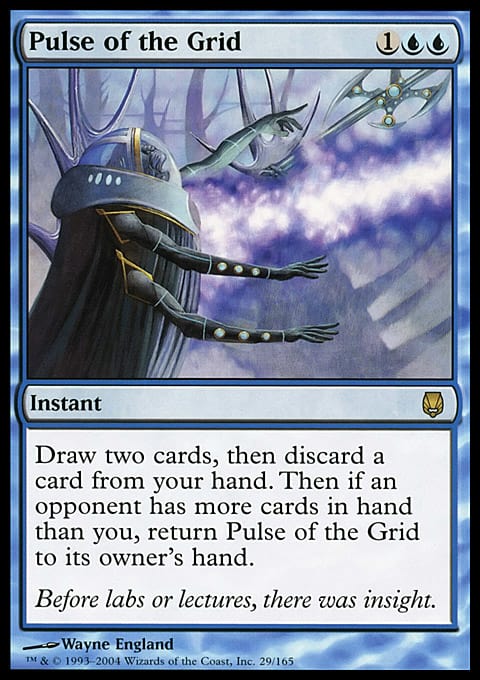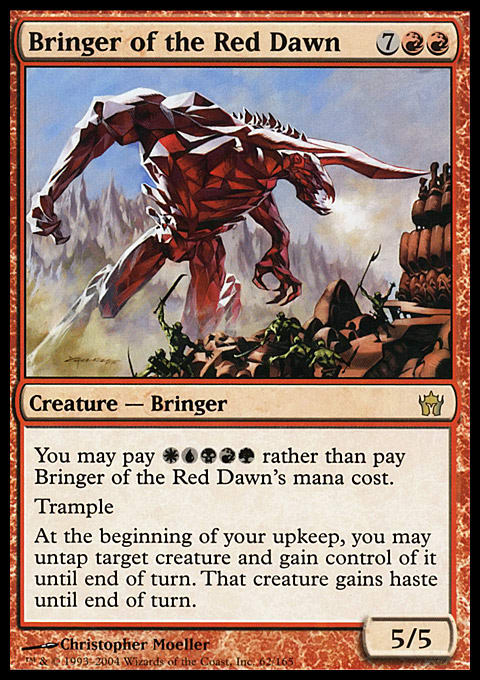My intention was to put Mirrodin and Scars of Mirrodin blocks in the same article, and with two cycles today, I dip into Scars block. But even as Mirrodin block has the fewest cycles of any block between the Urza and Zendikar blocks, there’s plenty to say about them, as you get some doozies.
A reminder of the parameters:
- I’m looking at horizontal cycles (Titans), not vertical cycles (Penumbra Bobcat/Penumbra Kavu/Penumbra Wurm). They need at least five cards, though they don’t have to be in five colors.
- No all-common cycles. They tend to be boring.
- No land/mana cycles. They tend to be too similar for my purposes. Besides, every dual land is good.
I’m grading each cycle on three categories:
- Playability – Does this cycle have any cards people want to play?
- Depth – Was it hit-or-miss or strong overall?
- Resonance – Memorable cycles should be able to pass the flavor test, although some cycles are mechanical and are not intended to have shared flavor. Still, making all the cards cost the same, have similar names, or share other characteristics can make a cycle memorable when it otherwise wouldn’t be.
Here goes!
Scars of Mirrodin
The Sliths
(Slith Ascendant, Slith Strider, Slith Bloodletter, Slith Firewalker, Slith Predator, and Arcbound Slith from Darksteel)
Playability: B+
Depth: C−
Resonance: B
Each creature is a cheaply costed 1/1 that receives a +1/+1 counter for dealing combat damage to a player. The ability’s turned out to be quite memorable such that Innistrad-block Vampires are said to have the “Slith mechanic.” That’s pretty impressive in its way.
But it’s the only thing making it a good cycle. Slith Firewalker was an important part of red decks in that era, as a 2-drop with haste and scalability is just fine—it’s very close to an uncommon Stromkirk Noble, after all. Slith Ascendant ought to be fine in casual; it’s come this close to making several of my decks. And if you’re looking for arcbound creatures, you could do a lot worse than Arcbound Slith, the adopted sixth Slith (there’s a Magic tongue twister for you). But the others need serious help; versus the Gatherer rating community, I’m harsh on Slith Strider, but a 1/1 for ![]()
![]()
![]() had better do more in my estimation.
had better do more in my estimation.
So, I can’t give good marks for depth, but at least that mark is easy to give out. The resonance mark, on the other hand, is one of the strangest composites I’ve had to deal with this entire series. They have unique creature types—good! They’re 1/1s with partially the same ability, an ability that’s now named after them—good! They’re drawn by Justin Sweet—good! Except . . . Arcbound Slith is drawn by Vance Kovacs, who drew no other Sliths and no other arcbound creatures. That’s just confusing.
While the cycle’s mixed, Morrissey made a fine career for himself after he left the Sliths. Maybe that joke isn’t funny anymore . . .
Shards of Mirrodin
(Pearl Shard, Crystal Shard, Skeleton Shard, Granite Shard, Heartwood Shard)
Playability: B+
Depth: C−
Resonance: B+
Yes, it’s a similar grade to the Sliths. The Resonance uptick is from being drawn by a single artist, Doug Chaffee. But while Crystal Shard is a Commander favorite, enabling frequent reuse of enters-the-battlefield (ETB) abilities and Skeleton Shard is a good role player, the others are ciphers. Heartwood Shard inspires so much antipathy that it has a lower Gatherer rating than War Chariot, an Ice Age card it’s strictly better than. Granite Shard’s fine but weak; Pearl Shard’s in the same category.
It’s always tricky designing artifacts with color implications. You have to make sure you’re not bleeding the color pie too heavily, and I think from a design standpoint these are nice. That doesn’t make them all good, however.
The Color Identity Artifacts
(Leonin Sun Standard, Proteus Staff, Altar of Shadows, Bosh, Iron Golem, Tangleroot)
Playability: B+
Depth: B+
Resonance: C− (I’ve played with or against four of these cards and never would have guessed they were a cycle.)
Bosh is the best-known of these for being one of the legendary creatures that “liberated” by the color-identity rule to be a legal commander, which he’s quite good at if your metagame isn’t intent on destroying artifacts (mine normally is because I’m in it). Bosh saw some play in older formats; there was a George W. Bosh deck type for a while. I like Altar of Shadows in Commander, as it’s both a mana sink and a mana producer. It’s clunky at doing both, but as extra flexibility, it’s fine. It’s at its best in a sweeper-heavy deck, as the Altar then becomes a way to kill the best creature every round while gaining mana for something (Comet Storm’s a favorite).
Proteus Staff is finicky but fun; I have it in a sixty-card mono-blue deck around Wellsprings, Surveilling Sprite/Darkslick Drake, Read the Runes, and the like to thin out the deck and start using Proteus Staff as a means of recycling the imprint on Phyrexian Ingester. Leonin Sun Standard, an update on Gerrard's Battle Cry, is straightforward; Tangleroot isn’t, but both cards are useful. This is pretty much a casual cycle now, but it’s a group of solid cards. After two easily identifiable but uneven cycles, I’m fine with that.
The Towers
(Tower of Eons, Tower of Fortunes, Tower of Murmurs, Tower of Calamities, Tower of Champions)
Playability: B−
Depth: B+
Resonance: A
This one’s an unexpected story. Read here under Tower of Calamities for an application of cycles, resonance, and player expectations. Basically, this wasn’t a cycle, just four cards with various abilities, but players read it as a cycle missing a red Tower, so they designed Tower of Calamities as the red one. Even better, it deals 12 damage because the other cards had four/six/eight/ten abilities. They’re merely okay, with their best uses probably in Commander decks normally in the wrong colors for the abilities (and therefore willing to pay more mana for the effect, e.g. Tower of Fortunes), but the initial design, player reaction, and WotC’s response are all instructive.
Darksteel
The Lucky Charms
(Angel's Feather, Kraken's Eye, Demon's Horn, Dragon's Claw, Wurm's Tooth)
Playability: B
Depth: D
Resonance: C−
I have to give higher marks to Playability than their inclusion in noob decks and booster packs as a dud uncommons might imply because Dragon's Claw was a real sideboard card whenever mono-red was a Standard force. Kraken's Eye is abusable in the way the other ones aren’t thanks to Eye of the Storm insisting that each copy every player gets of previous instants or sorceries is cast; if you build mono-blue Eye of the Storm with Kraken's Eye, you’re basically giving everyone a set of blue combo spells, and Kraken's Eye can generate for you over 50 life with little effort. And this cycle’s better than the Throne of Bone cycle. They also look good in the Ninth Edition black-bordered Russian printing, though pretty much everything does.
The thing that’s annoying me most right now about this cycle is simple: There are no Krakens in Mirrodin. Where would an eye come from, then? It’s an impostor eye. Faken’s Eye, more like.
The Swords
(Sword of Light and Shadow, Sword of Fire and Ice, Sword of Feast and Famine, Sword of War and Peace, Sword of Body and Mind)
Playability: A+
Depth: A
Resonance: A−
They’re as iconic as they come, the cycle identification so strong that not only was its completion hotly anticipated entering Scars block, but the individual card abilities are slightly less remembered for how tight the cycle is. Different artists—Mark Zug in 2003 and Chris Rahn later—made different blade shapes, but Rahn’s artwork is a clearer and generally improved callback to the originals, tying the color swirls on each side of the blade to Mirrodin suns rather than to Oatmeal Swirlers.
You know they’re good; everybody knows they’re good; and along with whatever shows up in Return to Ravnica block, they’ll comprise what probably will be the only rare/mythic cycle ever. But don’t do as my Friday Night Magic opponent did, hitting me with Sword of Body and Mind when I was struggling to get in the game and milling Unburial Rites and Elesh Norn, Grand Cenobite. Well, if you’re playing me, do that every time, come to think of it.
The Pulses
(Pulse of the Fields, Pulse of the Grid, Pulse of the Dross, Pulse of the Forge, Pulse of the Tangle)
Playability: B
Depth: A−
Resonance: A
The reusability of these cards when you’re down in a specific resource normally doesn’t make up for their inefficiency. There are two artists for the cycle, which is unusual (one or several is the norm), but it works. The main thing is that they all cost 1CC and have parallel flavor texts explaining that each pulse is a primal magical urge. For example, Pulse of the Grid informs us that, “Before labs or lectures, there was insight.” I like this cycle more than I comment on it, not because I like it a lot, but because there’s not much to say on them. But they’re good, and they have significance to a New Phyrexia cycle, so there’s that.
Fifth Dawn
The Beacons
(Beacon of Immortality, Beacon of Tomorrows, Beacon of Unrest, Beacon of Destruction, Beacon of Creation)
Playability: A
Depth: A
Resonance: B
These are all hits in the casual realm and deservedly so. Beacon of Immortality sees sparse tournament play as a win condition with False Cure, but this is generally a group you see in casual, especially as long multiplayer games increase your odds of seeing them again. My personal favorite use of the shuffling in is with Beacon of Destruction and Urza's Hot Tub naming “of”; Kami of the Blah Blah becomes potent when it turns into 5 to the dome every time. (Seizan, Perverter of Truth makes an excellent complement to the strategy.)
The only issue I have with this cycle is the flavor texts, some of which seem conceived together but not against the other ones. Immortality’s, Unrest’s, and Creation’s sound like a dungeon master’s descriptions of your surroundings, an unusual device on a Magic card. Tomorrows and Destruction are also in present tense, but they’re descriptive of effects like any other flavor text. Basically, three flavor texts gave the opportunity to make one of the most vivid cycles of flavor text ever, and either they didn’t catch this opportunity or they squandered it. Either way, I don’t like it.
The Bringers
(Bringer of the White Dawn, Bringer of the Blue Dawn, Bringer of the Black Dawn, Bringer of the Red Dawn, Bringer of the Green Dawn)
Playability: B+
Depth: A−
Resonance: A−
They’re all 5/5 tramplers for 9 mana theoretically—but ![]()
![]()
![]()
![]()
![]() in practice—and thoroughly sweet upkeep triggers. They’re of the unique creature type Bringer (an easy way to suck me in), and Bringer of the Blue Dawn looks like rock candy. Their use is narrow but very fun. I’ve had a Bringer deck for a couple years; it’s extremely high-variance, but it can come out of the gates incredibly fast. It’s a nice break from most of my decks.
in practice—and thoroughly sweet upkeep triggers. They’re of the unique creature type Bringer (an easy way to suck me in), and Bringer of the Blue Dawn looks like rock candy. Their use is narrow but very fun. I’ve had a Bringer deck for a couple years; it’s extremely high-variance, but it can come out of the gates incredibly fast. It’s a nice break from most of my decks.
"Bring It"
- Creatures (13)
- 2 Bringer of the White Dawn
- 2 Bringer of the Blue Dawn
- 2 Bringer of the Black Dawn
- 2 Bringer of the Red Dawn
- 2 Bringer of the Green Dawn
- 3 Composite Golem
- Spells (23)
- 3 Maelstrom Nexus
- 3 Kaleidostone
- 2 Legacy Weapon
- 4 Search for Tomorrow
- 4 Farseek
- 4 Channel the Suns
- 3 Explore
This sequence of turns is the ideal:
- Forest, suspend Search for Tomorrow
- Plains, Farseek for an Island
- Mountain, cast the suspended Search for Tomorrow for a Swamp, play something for





Channel the Suns and other cards can get there, too, if you need. Once you have reliable ![]()
![]()
![]()
![]()
![]() , assuming you’re still at a decent life total, things become fun. Maelstrom Nexus takes advantage of the Bringers’ high converted mana costs; cascading into Legacy Weapon is about as Timmy–Johnny as you can be. If you cascade into the lower-cost spells, they fetch a land, draw a card, or add
, assuming you’re still at a decent life total, things become fun. Maelstrom Nexus takes advantage of the Bringers’ high converted mana costs; cascading into Legacy Weapon is about as Timmy–Johnny as you can be. If you cascade into the lower-cost spells, they fetch a land, draw a card, or add ![]()
![]()
![]()
![]()
![]() to your mana pool; all you get off the cascade is something you want. Don’t forget that multiple Maelstrom Nexuses give multiple instances of cascade to the first spell you cast each turn.
to your mana pool; all you get off the cascade is something you want. Don’t forget that multiple Maelstrom Nexuses give multiple instances of cascade to the first spell you cast each turn.
Kaleidostone and Composite Golem are good value with Bringer of the White Dawn; bringing back Composite Golem every upkeep to feed into Legacy Weapon turns the trigger into “Exile target permanent,” which is a fine upkeep trigger in my opinion. The blue and black Bringers help ensure you maintain your advantages, green adds to the defense, and red is the best offensive option. Should you manage to bring multiple Bringers out (which, as the point of this deck, isn’t incredibly hard), things get silly.
The deck’s combo/all-in nature goes against my normal types and recommendations, but playing all members of a cycle in the same deck, especially when they’re Bringers, fits right into everything I’ve ever written. It’s difficult to discuss this cycle in the abstract, so it’s fortunate I have a deck for them that’s loads of fun.
Conclusion
Mirrodin block was low on cycles, and some of them are subpar, but what cycles are good are particularly high on casual playability overall. They probably take a hit in the eyes of many for spotty translation to Commander (color identity’s a big issue there), but the Swords ensure that the block isn’t forgotten.

















